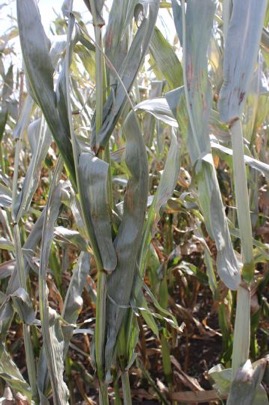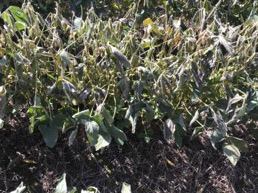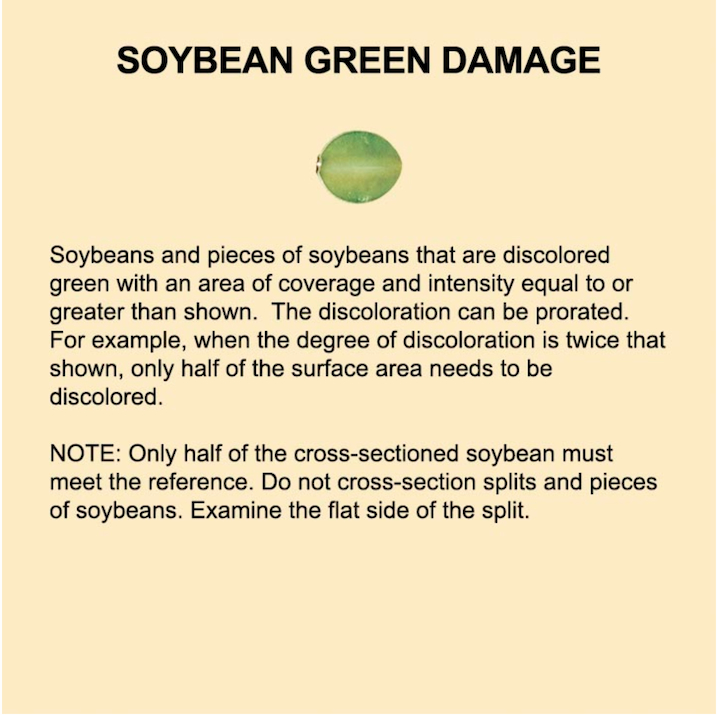Brought to you by: Jonah T. Johnson, MS, CPAg, CCA - Sales Agronomist, PCT | Sunrise
October 22, 2019: Going to have a “late harvest” in 2019? If you have frost damaged corn and/or soybeans, check out these tips on grain handling!
2019 has brought many challenges throughout the entire growing season, and for some of us, it’s not over yet. Harvest has been in full swing for many operations across Ohio, but for some, the extra ordinarily late planting dates still have some operations with green corn and soybeans. As I hope the next couple weeks will allow for these crops to reach maturity, there is a possibility that some crops will experience a killing frost prior to reaching maturity.
A killing frost is defined as two hours at 28 degrees Fahrenheit. When corn reaches black layer, moisture levels are typically around 30 percent. Soybeans can range in moisture depending upon the maturity percentage the entire plant was prior to the freeze event. Handling grain from plants that were prematurely killed will take some additional care. The following excerpts are from Iowa State University that elaborate on this very topic.
Harvest consideration for frost killed corn
Natural maturity is often determined when a black layer is formed at the kernel tip. At this timeframe grain moisture is typically 28–35% moisture. If a frost or freeze occurs a black layer can still form, however, grain moisture will be greater than 35%. A light frost of greater than 28oF for only a couple hours may kill some leaves, especially in the upper canopy. A freeze of 28oF or less for a couple hours will result in whole plant death.
Whether maturity is natural or induced by a frost, grain dry matter accumulation has finished. Incomplete grain fill from a frost or freeze often results in corn with low test weight that is greater than 35% moisture. The severity depends on how far the milk line has progressed at the time of the cold temperatures. At ¼ milk line the kernel moisture will be higher, and the kernel weight will be lower compared to ¾ milk line. Expect dry down in the field to take longer because of a higher kernel moisture and slower dry down rates because there is continued moisture exchange with the cob.
Grain yield decreases the earlier a killing frost occurs (ranges from 12% in late dent up to 41% at beginning dent stage). Yield losses are also less when only leaves are killed (ranges from 6% in late dent up to 27% at beginning dent stage). In addition to lower yield, incomplete grain will occur resulting in a lower test weight. Expect test weight to be in the low 50s to 40s (pounds/bushel). Lighter kernels will require fine adjustments to combine settings. Recognize the effects frost and freeze to corn ahead of natural maturity results in more susceptibility to breaking, lower grain protein, and lower digestibility.
Grain moisture of frost injured corn is deceptively low because the outer portion of the kernel dries quicker than the interior. Often grain moisture is 1–2% higher than many grain moisture meters, however, the newer 150 mhz units used by many elevators are more accurate. Dry frost killed corn 1–2% lower than the typical 14–15% and cool grain as quickly as possible. It will take more energy per unit of moisture removed to dry frost damaged corn. Storage life drops rapidly below 53 pounds/bushel test weight.
A killing frost is defined as two hours at 28 degrees Fahrenheit. When corn reaches black layer, moisture levels are typically around 30 percent. Soybeans can range in moisture depending upon the maturity percentage the entire plant was prior to the freeze event. Handling grain from plants that were prematurely killed will take some additional care. The following excerpts are from Iowa State University that elaborate on this very topic.
Harvest consideration for frost killed corn
Natural maturity is often determined when a black layer is formed at the kernel tip. At this timeframe grain moisture is typically 28–35% moisture. If a frost or freeze occurs a black layer can still form, however, grain moisture will be greater than 35%. A light frost of greater than 28oF for only a couple hours may kill some leaves, especially in the upper canopy. A freeze of 28oF or less for a couple hours will result in whole plant death.
Whether maturity is natural or induced by a frost, grain dry matter accumulation has finished. Incomplete grain fill from a frost or freeze often results in corn with low test weight that is greater than 35% moisture. The severity depends on how far the milk line has progressed at the time of the cold temperatures. At ¼ milk line the kernel moisture will be higher, and the kernel weight will be lower compared to ¾ milk line. Expect dry down in the field to take longer because of a higher kernel moisture and slower dry down rates because there is continued moisture exchange with the cob.
Grain yield decreases the earlier a killing frost occurs (ranges from 12% in late dent up to 41% at beginning dent stage). Yield losses are also less when only leaves are killed (ranges from 6% in late dent up to 27% at beginning dent stage). In addition to lower yield, incomplete grain will occur resulting in a lower test weight. Expect test weight to be in the low 50s to 40s (pounds/bushel). Lighter kernels will require fine adjustments to combine settings. Recognize the effects frost and freeze to corn ahead of natural maturity results in more susceptibility to breaking, lower grain protein, and lower digestibility.
Grain moisture of frost injured corn is deceptively low because the outer portion of the kernel dries quicker than the interior. Often grain moisture is 1–2% higher than many grain moisture meters, however, the newer 150 mhz units used by many elevators are more accurate. Dry frost killed corn 1–2% lower than the typical 14–15% and cool grain as quickly as possible. It will take more energy per unit of moisture removed to dry frost damaged corn. Storage life drops rapidly below 53 pounds/bushel test weight.

Frost Damage to Soybeans
Because of the very late planting season, some crops were immature enough to be injured by the freezing temperatures. Frost normally forms early in the morning, driven by radiation cooling especially on clear cold nights. The visual impact of the frost damage is most evident the next day (Figure 1).
Because of the very late planting season, some crops were immature enough to be injured by the freezing temperatures. Frost normally forms early in the morning, driven by radiation cooling especially on clear cold nights. The visual impact of the frost damage is most evident the next day (Figure 1).

Figure 1. Frost-damaged soybeans with shriveled and discolored leaves. Photo courtesy of Rebecca Vittetoe.
Temperatures below 32°F can damage soybean leaves, and temperatures below 30°F for an extended time periods can damage the stems, pods, and seeds. A killing freeze is considered to be 28°F for soybeans.
The severity of frost damage to soybeans depends on the following: how low the temperatures dropped, the duration of the cold temperatures, and the growth stage of the soybeans. Soybean fields with at least one mature pod on the main stem of each plant (R7 growth stage) are likely to be minimally affected by frost. Soybean plants with green pods will be more affected by frost. If the frost just damaged soybean leaves, particularly in the upper canopy, pods and seeds will continue to develop with yield minimally affected.
If the frost was more severe and damaged the stems, pods, and seed, the potential for reduced yield and quality is higher. In addition to reduced yield and quality, severely frost-damaged soybeans will dry down more slowly and be more likely to shatter at harvest. Farm moisture meters and older elevator meters will read about 1.5-2% points low until moisture and color have equalized. The new 150 mhz meters used by many elevators are more accurate.
Handling frost-damaged soybeans
If you do have frost damage to your soybeans, it is suggested to not sell the soybeans immediately as this is when the soybeans will have the most grain discoloration and the highest moisture. They will appear worse than they will end up after aeration. Instead, if you do harvest the field shortly after a frost, it is recommended to put the soybeans in an aerated bin. With air and drying, the green discoloration will subside somewhat over time.
Grain grading of frost-damaged soybeans
Green damage (frost) is an Official damage category in the USDA Grades. Green color will result in price discounts; however, greenness must be fairly intense and comprehensive to be classed as damage. Figure 2 is the USDA statement and example color photo of frost damage.
The severity of frost damage to soybeans depends on the following: how low the temperatures dropped, the duration of the cold temperatures, and the growth stage of the soybeans. Soybean fields with at least one mature pod on the main stem of each plant (R7 growth stage) are likely to be minimally affected by frost. Soybean plants with green pods will be more affected by frost. If the frost just damaged soybean leaves, particularly in the upper canopy, pods and seeds will continue to develop with yield minimally affected.
If the frost was more severe and damaged the stems, pods, and seed, the potential for reduced yield and quality is higher. In addition to reduced yield and quality, severely frost-damaged soybeans will dry down more slowly and be more likely to shatter at harvest. Farm moisture meters and older elevator meters will read about 1.5-2% points low until moisture and color have equalized. The new 150 mhz meters used by many elevators are more accurate.
Handling frost-damaged soybeans
If you do have frost damage to your soybeans, it is suggested to not sell the soybeans immediately as this is when the soybeans will have the most grain discoloration and the highest moisture. They will appear worse than they will end up after aeration. Instead, if you do harvest the field shortly after a frost, it is recommended to put the soybeans in an aerated bin. With air and drying, the green discoloration will subside somewhat over time.
Grain grading of frost-damaged soybeans
Green damage (frost) is an Official damage category in the USDA Grades. Green color will result in price discounts; however, greenness must be fairly intense and comprehensive to be classed as damage. Figure 2 is the USDA statement and example color photo of frost damage.

Figure 2. Frost-Damaged Kernels (Green). Soybeans and pieces of soybeans which are discolored green in cross section.
(Reference: Visual Reference Image No. SB-3.0 Green Damage) Source:http://www.gipsa.usda.gov/vri/soybean_3.0.asp
Processors will be concerned about green soybeans because of the likely lower oil yield and the need to remove the green color from the oil by more intensive refining. While some processors use Official Federal graders, there will likely be problems in grading as local markets may call anything somewhat green “damage”. Federal graders are trained in color differentiation. Five samples or more, with varying degrees of greenness, can be taken to an Official Federal grader to "calibrate" house grading.
References:
Iowa State University “Integrated Crop Management” Blog
https://crops.extension.iastate.edu/blog/charles-r-hurburgh-meaghan-anderson-rebecca-vittetoe/frost-damage-soybeans-0
https://crops.extension.iastate.edu/blog/charles-r-hurburgh-mark-licht/harvest-consideration-frost-killed-corn
References:
Iowa State University “Integrated Crop Management” Blog
https://crops.extension.iastate.edu/blog/charles-r-hurburgh-meaghan-anderson-rebecca-vittetoe/frost-damage-soybeans-0
https://crops.extension.iastate.edu/blog/charles-r-hurburgh-mark-licht/harvest-consideration-frost-killed-corn